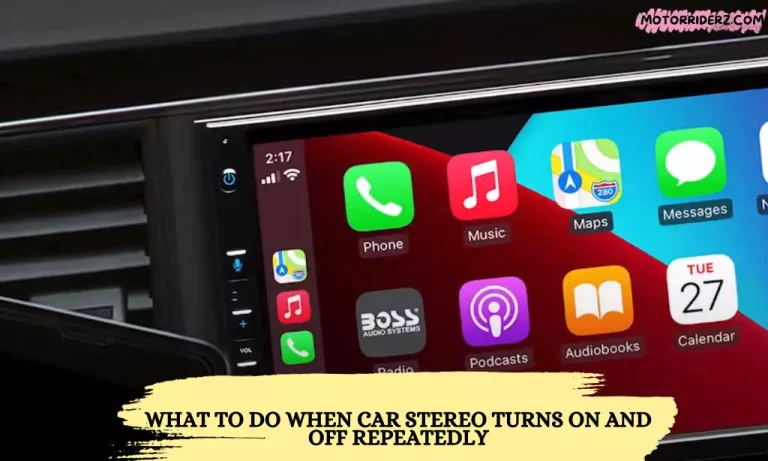What Is The Difference Between 2 Ohm And 4 Ohm Car Speakers?
The difference between 2 ohm and 4 ohm car speakers is that 2 ohm speakers generally provide cleaner bass sounds, while 4 ohm speakers are more common and offer a wider range of options. The choice between the two depends on personal preference and the specific requirements of the audio system.
When it comes to car speakers, considering their impedance (ohms) is crucial as it affects the power output from the amplifier and the overall sound quality. Car audio enthusiasts often prefer 2 ohm speakers for a smoother bass response, but 4 ohm speakers are more widely available and compatible with a variety of car audio systems.
Ultimately, it is recommended to consult with a professional to determine the best option for your specific needs.
Unraveling The 2 Ohm Vs 4 Ohm Car Speaker Puzzle
Understanding the difference between 2 Ohm and 4 Ohm car speakers is essential to make an informed decision when it comes to upgrading your car audio system. The speaker impedance, measured in Ohms, plays a crucial role in determining the performance and compatibility of your car speakers. The lower the Ohm rating, the easier it is for the current to flow through the speaker, resulting in higher power output. On the other hand, speakers with higher Ohm ratings tend to be more resistant to current flow, requiring more power for the same volume level.
Contrary to common misconceptions, the choice between 2 Ohm and 4 Ohm car speakers is not about finding the best option. Rather, it depends on various factors such as the capabilities of your amplifier, the size of your car, and personal preferences. It’s important to understand that different speakers have different power handling capabilities, and matching the impedance of your speakers with your amplifier is crucial to achieving optimal sound quality.
To sum up, understanding the importance of speaker impedance can help you make an informed decision about the ohm ratings of your car speakers. It’s essential to consider factors such as amplifier compatibility, power handling capabilities, and personal preferences when choosing between 2 Ohm and 4 Ohm car speakers.
Basics Of Car Speaker Impedance
The difference between 2 Ohm and 4 Ohm car speakers lies in their impedance, which is measured in Ohms and represents the electrical resistance the speaker offers to the audio signal coming from the amplifier. Impedance affects the performance and compatibility of the speaker with the audio system.
Ohm is a unit of electrical resistance, and it measures how much the speaker resists the flow of electrical current. The lower the Ohm rating, the less resistance the speaker offers, allowing more power to flow through and resulting in louder sound. On the other hand, higher Ohm ratings have more resistance, which means less power is delivered, resulting in lower volume.
In car audio systems, the role of impedance is crucial. A car amplifier is designed to work with a specific range of speaker impedance, and using speakers with a lower or higher impedance than recommended can lead to poor audio quality, decreased power output, and potential damage to the amplifier or speakers.
In conclusion, understanding the difference between 2 Ohm and 4 Ohm car speakers is important to ensure optimal audio performance and compatibility with the car audio system.
Inside 2 Ohm Car Speakers
The difference between 2 ohm and 4 ohm car speakers lies in their electrical impedance. While 2 ohm speakers provide a cleaner bass sound, 4 ohm speakers offer more compatibility and flexibility with audio systems. It’s important to consider your car’s audio setup and desired sound quality when choosing between the two.
| Inside 2 Ohm Car Speakers |
| Characteristics of 2 ohm speakers: |
| 2 ohm car speakers have a lower impedance rating compared to the standard 4 ohm speakers commonly found in car audio systems. This lower impedance allows more current to flow through the speakers, resulting in increased power output and potentially louder sound. |
| Advantages of using 2 ohm speakers in cars: |
| Using 2 ohm speakers can enhance the overall audio experience in cars. The lower impedance can provide better bass response and improved sound quality. Additionally, they can also handle higher power levels, allowing you to push your speakers to their limits. |
| Potential drawbacks of 2 ohm speakers: |
| While 2 ohm speakers offer advantages, they also come with some potential downsides. They require more power from the amplifier, which can put more strain on the electrical system of the car. Additionally, certain car audio systems may not be compatible with 2 ohm speakers, limiting your options. |
| Ideal scenarios for 2 ohm speaker usage: |
| 2 ohm speakers are ideal for those looking to upgrade their car audio system, especially if they prefer deep bass and improved sound quality. Additionally, if you have a powerful amplifier and a compatible car audio system, 2 ohm speakers can enhance your listening experience. |
Understanding 4 Ohm Car Speakers
4 ohm car speakers have distinct features that set them apart from other types of speakers. One of the benefits of opting for 4 ohm speakers is that they provide a cleaner bass sound. The bass produced by these speakers may not necessarily be louder, but it is of higher quality. This makes them ideal for those who want a more immersive audio experience in their car.
However, it is important to be aware of the limitations associated with 4 ohm speakers. These speakers require more power to function optimally compared to speakers with higher impedance. This means that you may need to invest in a powerful amplifier to ensure that the speakers deliver the best performance.
Situations where 4 ohm speakers shine include setups where high power output is desired, such as in car audio competitions or custom sound systems. These speakers can handle more power, allowing for louder and more impactful sound. Additionally, they can be a good option for those who are looking to upgrade their car audio system and want to achieve cleaner and more defined audio quality.
Comparing Power Handling And Quality
In the world of car speakers, understanding the difference between 2 ohm and 4 ohm speakers is crucial. One key difference lies in power handling. 2 ohm speakers generally require more power from the amplifier compared to 4 ohm speakers. This means that if you have a low-powered amplifier, it may struggle to drive 2 ohm speakers to their full potential. On the other hand, a high-powered amplifier is better suited for 2 ohm speakers as it can deliver the necessary power.
Another factor to consider is the impact on sound quality and volume levels. 2 ohm speakers tend to produce louder sound compared to 4 ohm speakers. However, it’s important to note that volume alone doesn’t determine sound quality. The tonal balance, clarity, and overall performance also play important roles.
Amplifiers interact differently with different ohm ratings. Some amplifiers are designed to work specifically with certain ohm ratings, while others may be more versatile. It’s essential to match the amplifier’s ohm rating with the speaker’s ohm rating to ensure optimal performance and avoid damage to either component.
Installation And Compatibility Considerations
The difference between 2 Ohm and 4 Ohm car speakers lies in their impedance ratings. Impedance refers to the electrical resistance a speaker presents to the amplifier or car audio system. Matching speakers with the correct impedance is crucial for seamless installation and optimal performance.
For installation challenges, 2 Ohm speakers may require thicker wires and a more powerful amplifier as they demand more current than 4 Ohm speakers. Additionally, ensure that your car audio system can handle the lower impedance of 2 Ohm speakers, as some systems may only support higher impedance.
When it comes to compatibility, 4 Ohm speakers are more common and widely supported by car audio systems. They provide a safer option as they draw less current and are more forgiving in terms of wiring and compatibility issues. Moreover, most factory-installed car audio systems are designed for 4 Ohm speakers.
In conclusion, while both 2 Ohm and 4 Ohm car speakers have their advantages and considerations, compatibility and installation challenges should be taken into account when choosing the right speakers for your car audio system.
Making The Right Choice For Your Vehicle
When choosing between 2 ohm and 4 ohm car speakers, there are several factors to consider before making a decision. Firstly, it’s important to assess the compatibility of the speakers with your existing audio setup. Matching the ohm rating of the speakers to the amplifier is crucial to ensure optimal performance and prevent any potential damage. Additionally, personal preferences play a role in the final verdict. While 2 ohm speakers generally provide a higher power output and are more efficient, 4 ohm speakers offer better sound quality and are often recommended for high-end audio systems.
Here is a brief comparison between the two ohm ratings:
| 2 Ohm Speakers | 4 Ohm Speakers |
|---|---|
| Higher power output | Better sound quality |
| More efficient | Less strain on amplifier |
| Recommended for low-impedance setups | Ideal for high-end audio systems |
Ultimately, the choice between 2 ohm and 4 ohm car speakers depends on your specific needs and preferences. Considering the compatibility with your existing setup and weighing the pros and cons of each ohm rating will help you make an informed decision for the best audio experience in your vehicle.
User Experiences And Anecdotes
User Experiences and Anecdotes
Car audio enthusiasts have shared their real-world experiences with different ohm ratings in car speakers. One frequently observed misconception is the belief that lower ohm ratings, such as 2 ohms, automatically result in louder sound. However, this is not always the case. While lower ohm ratings may allow for more power to be delivered to the speakers, it doesn’t necessarily mean the sound will be louder. In fact, some users have reported that 2 ohm car speakers tend to produce cleaner bass, rather than being significantly louder. On the other hand, changing the ohm rating of car speakers can affect day-to-day usage. It’s important to consider the compatibility of the speakers with the amplifier and other audio components in the car. Having a mismatch between the speaker’s ohm rating and the amplifier’s capabilities can lead to issues such as distortion or reduced sound quality. Therefore, it’s essential to choose car speakers with the appropriate ohm rating based on the system’s compatibility and desired sound experience.
Conclusion
To sum it up, the difference between 2 ohm and 4 ohm car speakers lies in their electrical resistance. While 2 ohm speakers provide a lower impedance, which can result in louder and more powerful bass, 4 ohm speakers offer cleaner and more accurate sound quality.
When choosing car speakers, it’s essential to consider your amplifier’s compatibility and your personal preference for sound. Ultimately, finding the right ohm rating will ensure optimal audio performance in your vehicle.




